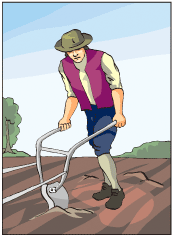Tools and technologies that changed the world
 According to the Encyclopedia Britannica, the plow is the "most important agricultural implement since the beginning of history" (Britannica, n.d., par. 1). Without the surplus food crops made possible by the plow, there would be no cities and no civilizations. The precursor to the plow was the digging stick—modified digging sticks with handles were probably the earliest plows. By Roman times, plows with light iron blades were pulled by oxen, suitable for the soil of the Mediterranean region, but unsuitable for the heavier soils, such as those found in northern Europe. Here the plow was modified with the addition of wheels and drawn by horses. As agriculture became more sophisticated, so did the plow. Today, "tractor-drawn plows have from 1 to 14 hydraulically lifted and controlled bottoms staggered in tandem" and there are deep tillage instruments as well, pulled by heavy tractors, capable of plowing three feet into subsoil (Britannica, pars. 3-6).
According to the Encyclopedia Britannica, the plow is the "most important agricultural implement since the beginning of history" (Britannica, n.d., par. 1). Without the surplus food crops made possible by the plow, there would be no cities and no civilizations. The precursor to the plow was the digging stick—modified digging sticks with handles were probably the earliest plows. By Roman times, plows with light iron blades were pulled by oxen, suitable for the soil of the Mediterranean region, but unsuitable for the heavier soils, such as those found in northern Europe. Here the plow was modified with the addition of wheels and drawn by horses. As agriculture became more sophisticated, so did the plow. Today, "tractor-drawn plows have from 1 to 14 hydraulically lifted and controlled bottoms staggered in tandem" and there are deep tillage instruments as well, pulled by heavy tractors, capable of plowing three feet into subsoil (Britannica, pars. 3-6).
The wheel is also an ancient invention. It changed the world in the realms of transportation, food production (millwheels and windmills), irrigation (water wheels), and gear-driven machines, such as timepieces and mechanical looms. As you might have noted in the previous paragraph, advances in plow technology would have been impossible without the wheel.
Other crucial technologies include the printing press, refrigeration, the light bulb…. The list goes on. For a look at 10 of these world-changing tools and technologies, click the following link.
https://www.britannica.com/list/10-inventions-that-changed-your-world
All of these tools and technologies have had a profound impact on Earth's environments and the people who live in these environments. Human technologies made an industrial revolution possible, and the consequences of this revolution are still unfolding. Production of material goods has led to overconsumption of resources, especially in the developed world, and dangerously high levels of carbon dioxide emissions, which are implicated in climate change and sea level rise. Due to these increasing levels of carbon dioxide, all living creatures are at risk for a number of health problems. Technology, modern methods of food production, and modern medicine have benefited humanity but have also led to what many scientists consider Earth's most pressing problem: overpopulation. Today, Earth's population is at seven billion and climbing.
For an even more in-depth look at human impacts and their environmental consequences, click here:
http://www.sciencedaily.com/news/earth_climate/environmental_issues/
Earth's population clock, with continuous updates, now includes a United States population clock:
http://www.census.gov/popclock/
LessonPlanet offers further exploration and lesson plans at all grade levels on the human impact on the environment.
http://www.lessonplanet.com/lesson-plans/human-impact-on-environment
The effects of tools and technologies on the environment
From the polar regions to the Equator, there are few if any places on Earth that have not felt the effect of human tools and technologies. Many areas of the planet have been put at risk by overuse or misuse of these tools and technologies.